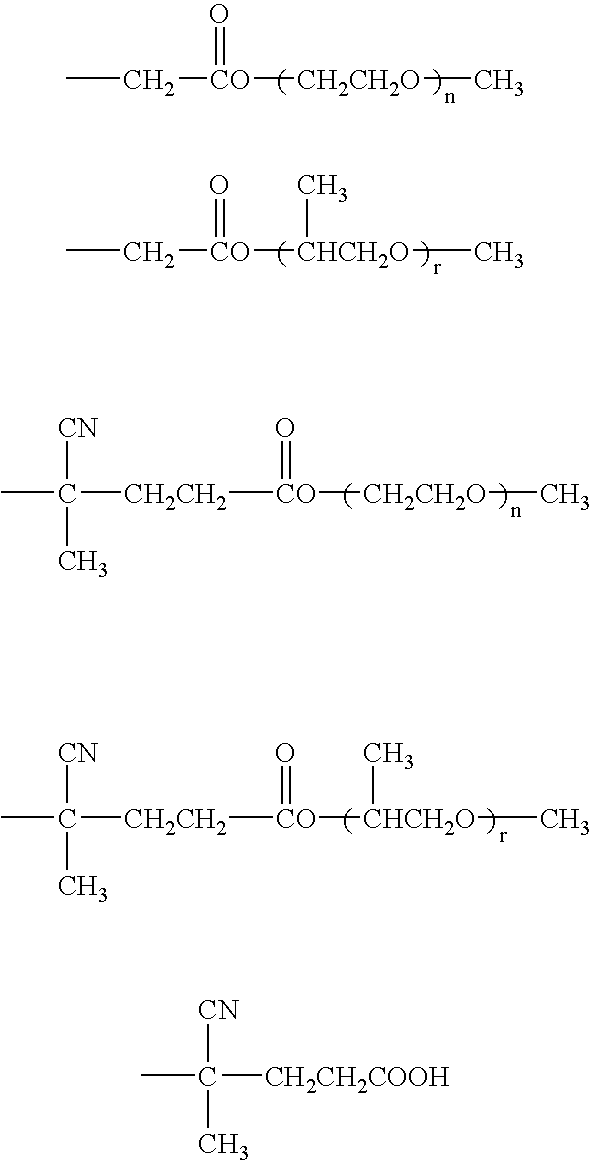Block copolymer
a copolymer and block technology, applied in the field of block copolymer, can solve the problems of little information about the polymerization of monomers, no production has been performed industrially, and no example has been known about the polymerization, etc., and achieve the effects of low temperature resistance, excellent heat resistance, and weatherability
- Summary
- Abstract
- Description
- Claims
- Application Information
AI Technical Summary
Benefits of technology
Problems solved by technology
Method used
Image
Examples
example 2
Synthesis of Mercapto Group-Terminated methacrylonitrile-n-butyl acrylate diblock copolymer
[0112] Into a 2 L reactor equipped with an agitator, a thermometer, a nitrogen gas inlet tube, a dropping funnel, and a reflux condenser, was placed 490 g of distilled water and 0.55 g of sodium dodecyl sulfate, and the reactor was nitrogen-purged while the reaction mixture was being stirred at 80.degree. C. A mixed solution of 11.3 g of methacrylonitrile and 1.08 g of a compound represented by formula (6): 18
[0113] was added into the reactor, and stirring was performed at 80.degree. C. for 20 minutes. Next, 0.93 g of 4,4'-azobis(4-cyanovaleric acid) together with 25 g of distilled water was added into the reactor. Stirring was performed at 80.degree. C. for 30 minutes, and then 57.7 g of methacrylonitrile was dripped from the dropping funnel for over 1 hour. After dripping was completed, stirring was performed at 80.degree. C. for 5 hours, and sampling was performed. Production of polymethacr...
example 3
Synthesis of Mercapto Group-Terminated acrylonitrile-(n-butyl acrylate / ethyl acrylate) diblock copolymer
[0116] Into a 300 mL reactor equipped with an agitator, a thermometer, a nitrogen gas inlet tube, a dropping funnel, and a reflux condenser, was placed 110 mg of sodium dodecyl sulfonate and 100 g of distilled water, and the reactor was nitrogen-purged while the reaction mixture was being stirred at 80.degree. C. A compound (217 mg) represented by formula (6): 19
[0117] which was dissolved in 1.6 g of acrylonitrile, was added into the reactor, and after 20 minutes, 185 mg of 4,4'-azobis(4-cyanovaleric acid) together with 5 g of distilled water was added into the reactor. Stirring was performed at 80.degree. C. for 20 minutes, and then 9.3 g of acrylonitrile was dripped from the dropping funnel for over 50 minutes. After dripping was completed, stirring was performed at 80.degree. C. for 3 hours, and sampling was performed. Production of polyacrylonitrile (Mw=18,100, Mn=12,700, and ...
example 4
Synthesis of Mercaptide Group-Terminated (acrylonitrile / methyl methacrylate)-(n-butyl acrylate / 2-hydroxyethyl acrylate) diblock copolymer
[0120] Into a 1 L reactor equipped with an agitator, a thermometer, a nitrogen gas inlet tube, a dropping funnel, and a reflux condenser, was placed 200 mg of sodium dodecyl sulfonate and 200 g of distilled water, and the reactor was nitrogen-purged while the reaction mixture was being stirred at 80.degree. C. A compound (651 mg) represented by formula (6): 20
[0121] which was dissolved in 5.0 g of methyl methacrylate, was added into the reactor, and after 20 minutes, 500 mg of 4,4'-azobis(4-cyanovaleric acid) together with 12 g of distilled water was added into the reactor. Stirring was performed at 80.degree. C. for 30 minutes, and then a mixed solution of 18.6 g of acrylonitrile and 6.8 g of methyl methacrylate was dripped from the dropping funnel for over 1 hour. Stirring was then performed at 80.degree. C. for 6 hours, and sampling was performe...
PUM
| Property | Measurement | Unit |
|---|---|---|
| Fraction | aaaaa | aaaaa |
| Fraction | aaaaa | aaaaa |
| Fraction | aaaaa | aaaaa |
Abstract
Description
Claims
Application Information
 Login to View More
Login to View More - R&D
- Intellectual Property
- Life Sciences
- Materials
- Tech Scout
- Unparalleled Data Quality
- Higher Quality Content
- 60% Fewer Hallucinations
Browse by: Latest US Patents, China's latest patents, Technical Efficacy Thesaurus, Application Domain, Technology Topic, Popular Technical Reports.
© 2025 PatSnap. All rights reserved.Legal|Privacy policy|Modern Slavery Act Transparency Statement|Sitemap|About US| Contact US: help@patsnap.com



